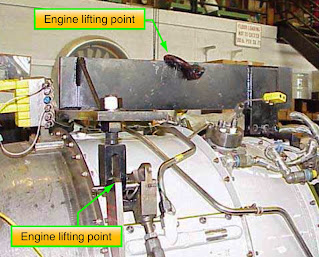If a QECA is being removed, the engine mount accompanies the engine. The mount remains on the aircraft if only the engine is being removed. Before the engine can be freed from its attachment points, a sling must be installed so the engine’s weight can be supported with a hoist when the mounting bolts are removed.
Aircraft engines, or QECAs, have marked points for attaching a hoisting sling. The location of these attaching points varies according to the size and weight distribution of the engine. Figure 1 shows a sling supporting an engine that has two attaching points. As a matter of safety, carefully inspect the sling for condition before installing it on the engine.
Before attaching the sling to the hoist, be sure that the hoist has sufficient capacity to lift the engine safely. The engine’s center of gravity (CG) should also be taken into account as the engine is hoisted. A manually operated hoist mounted in a portable frame is shown in Figure 2.
This hoist assembly is specifically manufactured for the purpose of removing engines and other large assemblies from aircraft. Some frames are fitted with power-operated hoists. These should be used with care, since considerable damage can be done if an inexperienced operator allows a power-operated hoist to overrun. The hoist and frame should also be checked for condition before being used to lift the engine.
Hoisting the Engine
Before the hoist is hooked onto the engine sling, recheck the aircraft tail supports and the wheel chocks. Fasten lines to the engine, at points on the sides or rear, so that the engine can be controlled as it is being hoisted. Hook the hoist onto the sling and hoist the engine just enough to relieve the engine weight from the mount attachments. Remove the nuts from the mount attachments in the order recommended in the manufacturer’s instructions for the aircraft. As the last nuts are being removed, pull back on the lines fastened to the engine (or force it back by other means if lines are not being used), thus steadying the engine. If bolts must be removed from the mount attachments, be sure the engine is under control before doing so. If the bolts are to remain in the mount attachments, the hoist can be gently maneuvered upward or downward as necessary after all the nuts have been removed. Meanwhile, gently relax the backward force on the engine just enough to allow the engine gradual forward movement when it is free from the mount attachments. When the hoist has removed all engine weight from the mount attachments, the engine should be eased gently forward, away from the aircraft. If the engine binds at any point, maneuver it with the hoist until it slips free.
The procedure just discussed applies to removal of most reciprocating and turbine aircraft engines. Any variation in details is outlined in the manufacturer’s instructions. Before attempting any engine removal, always consult these instructions for the aircraft concerned. When the engine has been removed, it can be carefully lowered onto a stand. The engine should be fastened to the stand and prepared for the removal of accessories.


